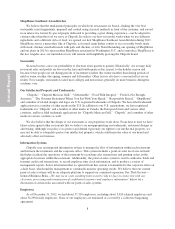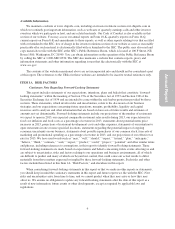Chipotle 2012 Annual Report Download - page 20
Download and view the complete annual report
Please find page 20 of the 2012 Chipotle annual report below. You can navigate through the pages in the report by either clicking on the pages listed below, or by using the keyword search tool below to find specific information within the annual report.
Nutrition and Food Regulation
In recent years, there has been an increased legislative, regulatory and consumer focus at the federal, state and
municipal levels on the food industry including nutrition and advertising practices. Restaurants operating in the quick-
service and fast-casual segments have been a particular focus. For example, the State of California, New York City and
a number of other jurisdictions around the U.S. have adopted regulations requiring that chain restaurants include
calorie information on their menu boards or make other nutritional information available. The U.S. health care reform
law included nation-wide menu labeling and nutrition disclosure requirements as well, and our restaurants will be
covered by these national requirements when they go into effect, which may be as early as 2013. Initiatives in the area
of nutrition disclosure or advertising, such as requirements to provide information about the nutritional content of our
food, may increase our expenses or slow customers as they move through the line, decreasing our throughput. These
initiatives may also change customer buying habits in a way that adversely impacts our sales.
Local Licensure, Zoning and Other Regulation
Each of our restaurants is also subject to state and local licensing and regulation by health, alcoholic
beverage, sanitation, food and workplace safety and other agencies. We may experience material difficulties or
failures in obtaining the necessary licenses or approvals for new restaurants, which could delay planned
restaurant openings. In addition, stringent and varied requirements of local regulators with respect to zoning, land
use and environmental factors could delay or prevent development of new restaurants in particular locations.
Environmental Laws
We are subject to federal, state and local environmental laws and regulations concerning the discharge,
storage, handling, release and disposal of hazardous or toxic substances, as well as local ordinances restricting
the types of packaging we can use in our restaurants. We have not conducted a comprehensive environmental
review of our properties or operations. We have, however, conducted investigations of some of our properties
and identified contamination caused by third-party operations. We believe any such contamination has been or
should be addressed by the third party. If the relevant third party does not address or has not addressed the
identified contamination properly or completely, then under certain environmental laws, we could be held liable
as an owner or operator to address any remaining contamination, sometimes without regard to whether we knew
of, or were responsible for, the release or presence of hazardous or toxic substances. Any such liability could be
material. Further, we may not have identified all of the potential environmental liabilities at our properties, and
any such liabilities could have a material adverse effect on our operations or results of operations. We also
cannot predict what environmental laws will be enacted in the future, how existing or future environmental laws
will be administered or interpreted, or the amount of future expenditures that we may need to make to comply
with, or to satisfy claims relating to, environmental laws.
Other Aspects of Regulatory Risk
From time to time we are the target of litigation in connection with various laws and regulations that cover
our business. The majority of this litigation occurs in California even though currently only about 17% of our
restaurants are located there. As we continue to expand in California, or if we are not able to effectively manage
the increased litigation risks and expenses we have experienced in California, our business may be adversely
impacted to a greater extent than if we did not operate in, or minimized our operations in, California.
Because we do not franchise, the costs of compliance and other risks associated with government regulation
of our business, as described above, may be more pronounced for us than for restaurant companies that shift
some or all of these risks to franchisees.
We could be party to litigation that could adversely affect us by distracting management, increasing our
expenses or subjecting us to material money damages and other remedies.
We’re subject to numerous claims alleging violations of federal and state laws regarding workplace and
employment matters, including wages, work hours, overtime, vacation and family leave, discrimination,
wrongful termination, and similar matters, and we could become subject to class action or other lawsuits related
18
Annual Report
























